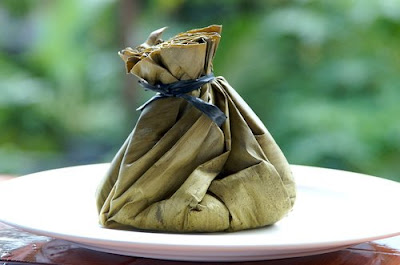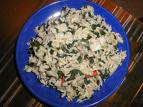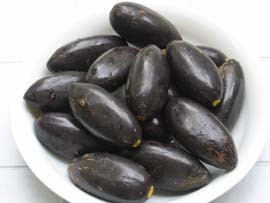 |
| My Filipino Paella |
I would like to share my Pilipino Paella recipe here that I always cook at home for my family. It is a complete dish as any Filipino would love it because the rice blends pretty well with the many ingredients. Its aroma and flavor will excite your palate to love this popular Spanish dish in your table. This is my own simple version as I have omitted many ingredients in the original recipe like Chorizo Bilbao, Olive oil, Saffron, Spanish paprika as local ingredients would be readily available in the market.
The dish is really delicious and it is not difficult to make as long as you could cook the rice right by good timing, not watery but firm and well cooked, evaporating the water in the rice. The rice is flavorful as it has absorbed all the aroma and flavor of the mixed ingredients of meat, Mussels, Chili, Chorizo that makes the real flavor of a true Paella. For Saffron, I used the local Katsuba threads to enhance the flavor of rice. This ingredient is popular in mixing rice dishes like Arrozcaldo, Valenciana, etc. . .I also used our local Chorizo to blend its flavor with all the ingredients in the recipe. To my mind, preparing Paella can be very simple just as you are cooking any dish from your kitchen. You could try my version just by following the simple directions here. My wife Edith, Ponchie, Agatha and Au loved it so much every time I prepare this popular dish at home. They said that the taste was really great and delicious!
The dish is really delicious and it is not difficult to make as long as you could cook the rice right by good timing, not watery but firm and well cooked, evaporating the water in the rice. The rice is flavorful as it has absorbed all the aroma and flavor of the mixed ingredients of meat, Mussels, Chili, Chorizo that makes the real flavor of a true Paella. For Saffron, I used the local Katsuba threads to enhance the flavor of rice. This ingredient is popular in mixing rice dishes like Arrozcaldo, Valenciana, etc. . .I also used our local Chorizo to blend its flavor with all the ingredients in the recipe. To my mind, preparing Paella can be very simple just as you are cooking any dish from your kitchen. You could try my version just by following the simple directions here. My wife Edith, Ponchie, Agatha and Au loved it so much every time I prepare this popular dish at home. They said that the taste was really great and delicious!
My Filipino Paella Recipe
Ingredients:
You will need a large non stick pan (14 inches), in place of Paellera with a good cover or an aluminum foil.
Chicken Wings 300 gms, about 6 pcs. chopped to bite sizes
1 Round Pork (Pigi) 300 gms, chopped to bite sizes
Medium Shrimps, 250 grms
Medium Shrimps, 250 grms
1/2 kilo Mussels, wash it well & soak in clean water before cooking
1 Chorizo Sausage, sliced
6 cups Sinandomeng rice (soak it for 20 mins in a bowl)
4 cloves of Garlic, chopped
2 Onions, medium, chopped
2 leaves of Laurel
200 grms raisins (optional)
200 grms raisins (optional)
6 pcs of medium Tomatoes, sliced
3 pcs med. carrots, sliced
300 grams Baguio beans, sliced
4 pcs med green chili (for sinigang)
3 pcs med. carrots, sliced
300 grams Baguio beans, sliced
4 pcs med green chili (for sinigang)
2 pcs red pepper or bell pepper
3 tbsp Corn Oil
1 &1/2 Knorr Chicken cubes
6 cups of water
2 sliced hard boiled eggs (Optional)
2 sliced hard boiled eggs (Optional)
Salt and Pepper to taste
Directions:
In a pan, with medium fire, place the corn oil and saute the garlic, onions until brown, then put the tomatoes, chili powder and laurel leaves. Put one at a time or gradually the chicken, pork, sliced Chorizo sausage to the pan until brown. Put 3 cups of water to cook the meat, cover it and then simmer it until tender. Then, put the Shrimps, Mussels, Carrots, Baguio beans and Chilis and raisins. After, 15 mins take out all the cooked meat, shrimps, mussels and vegetables and set aside leaving just the broth in the pan.
Put 6 cups of water and the Knorr Chicken cubes and cover it until boiling. Place the soaked 6 cups of rice (measuring cup from rice cooker). Then, cover it to cook the rice in high heat. Simmer the rice for another few minutes and cover it until the rice is fully cooked in low fire or better cover it tightly with aluminum foil. Put all the ingredients back to the pan and arrange it in a platter or just arrange the ingredients in the pan and garnish it with sliced boiled eggs with chopped spring onions. This Serving is good for 10 people.
Notes on Pilipino Paella:
a) In replacement of Saffron which is very expensive, I have the local Katsuba threads that you can find in the market. It could be a relative of Saffron and it really improve and heighten the flavor of Paella.
b) If you can't find Spanish Paprika in the Supermarket, McCormick spices are selling Paprika on selected stores in the market.
c) As soon as the rice is simmered in low fire to take out all the water in the rice, cover it with aluminum and bake it in the oven for 15-20 minutes.This will make the Paella even better.
d) Paellera, the pan used by the Spaniards for cooking Paella is available at Gourdo's and selected stores in the malls. I am considering to replace my pan with a Paellera. It costs P1,000+.
e) If you can use Olive oil, that's fine because it brings the goodness of the flavor of a true Paella. For me Corn oil or Vegetable oil is fine.
f) Many think Paella is hard to cook at home. No, not really. Just simply follow the guided directions in the recipe and you will surely enjoy Paella in your home.
g) If somehow, you have omitted some ingredients, that's okay. This dish doesn't require you to follow the original recipe. You can even add squid, octopus, crabs, fish or lobster that would suit your taste.
h) Some people add tomato paste or tomato sauce for this dish. That's okay!











